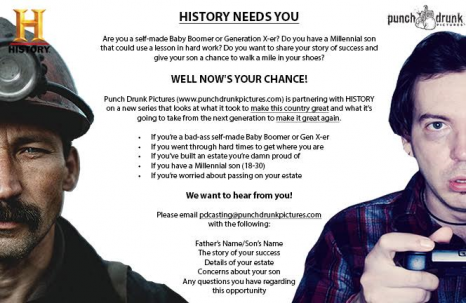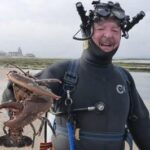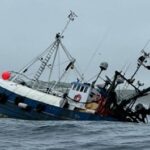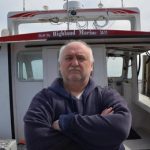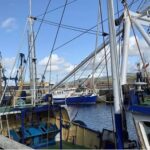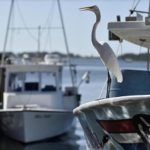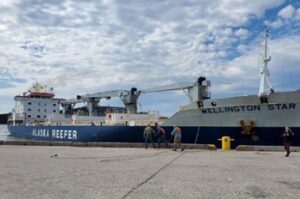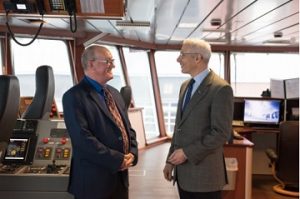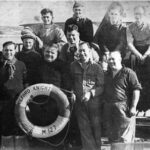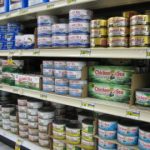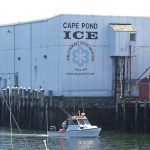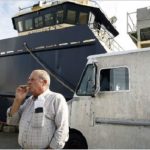Monthly Archives: May 2017
Trap Gear Closure Lifted; Right Whales Leaving Cape Cod Bay
 The trap closure extension in Cape Cod Bay has been lifted effective Friday May 5 because nearly all the whales that were aggregated in Cape Cod Bay have departed as expected. DMF filed emergency regulations last week to extend the prohibition of trap gear within certain waters of Cape Cod Bay. This closure extension was enacted because in mid-April there was an unprecedented aggregation of over 200 right whales feeding on dense plankton, and more than 100 remained just days before the scheduled May 1 opening. Feeding right whales are susceptible to entanglement in vertical buoy lines. click here to read the notice 22:55
The trap closure extension in Cape Cod Bay has been lifted effective Friday May 5 because nearly all the whales that were aggregated in Cape Cod Bay have departed as expected. DMF filed emergency regulations last week to extend the prohibition of trap gear within certain waters of Cape Cod Bay. This closure extension was enacted because in mid-April there was an unprecedented aggregation of over 200 right whales feeding on dense plankton, and more than 100 remained just days before the scheduled May 1 opening. Feeding right whales are susceptible to entanglement in vertical buoy lines. click here to read the notice 22:55
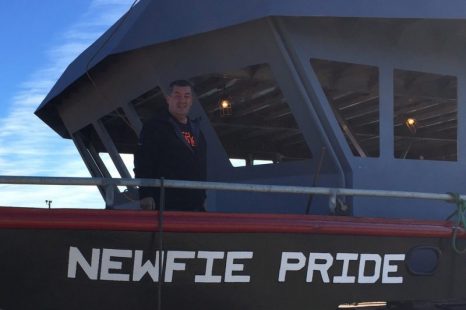
Northern Peninsula shrimp fishers see no reason to fish in 2017
The Fish, Food and Allied Workers (FFAW) union held a meeting for the 4R fleet in Hawke’s Bay on April 24. FFAW 4R chair, Rendell Genge, and the 4R vice chair, Roland Genge, both from Anchor Point, say that if the current outlook persists, in regards to prices and quotas, it’s likely that none of the 4R fleet will participate in the northern shrimp fishery this year. Earlier this year, the Department of Fisheries and Oceans (DFO) announced the northern shrimp quota in shrimp fishing area 6 (SFA 6) would be cut by 63 per cent. Coming on the heels of this was the news that the price for northern shrimp has dropped from $1.40 per pound in 2016 to $0.95 this year. The 4R fishers say they want better prices for shrimp before they can even think about fishing for it. To give a sense of how drastic the reductions in quotas and price would be this year, Roland explained the math. click here to read the story 21:18
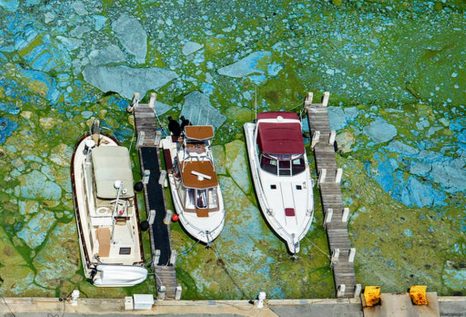
Florida’s building boom threatens wildlife-rich lagoon
The most biologically diverse waterway in America is seriously ill. The Indian River Lagoon is repeatedly being choked with oxygen-robbing algae, its surface increasingly dotted with thousands of dead fish, manatees, birds and other creatures. The culprits: farm runoff and a huge influx of people that has sent lawn fertilizer and other pollutants into the lagoon, which runs 156 miles along Florida’s Atlantic Coast, almost to Palm Beach, and includes the Cape Canaveral area. “It’s the death by a thousand cuts,” said Bob Knight, an environmental scientist with the Howard T. Odum Florida Springs Institute who has studied Florida’s waters for 40 years. The lagoon’s woes threaten the region’s $2.5 billion recreation, fishing and tourism economy, alarming kayak tour operators, charter boat captains, restaurateurs and organizers of bird-watching festivals. click here to read the story 19:48
Casting Call!
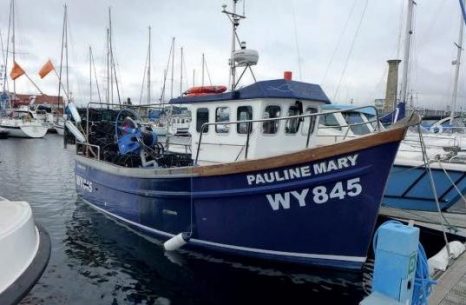
MAIB Report: Fisherman’s desperate attempts to save life of brother dragged beneath the waves off coast near Hartlepool
An experienced young fisherman became fatally entangled in ropes when unsafe practices were being carried out onboard a commercial fishing boat, a report has concluded. Lee Renney was dragged under water while working on the Pauline Mary off the coast of Hartlepool last September. Today, the Maritime Accident Investigation Branch has issued a damning report about the fatal accident. The 22-year-old was working alongside his brother, who was the skipper of the boat, when he was pulled overboard as he was dropping the lobster pots. Investigators said the brothers – both experienced fishermen from Hartlepool – had only been working on the Pauline Mary for two days and were laying out the pots for the first time from the vessel. click here to read the story 13:44
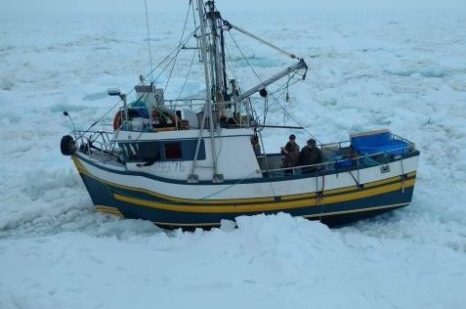
Sandy Stokes and the C.C.Venture spent four days stuck in Bonavista Bay
After days stuck in pack ice in Bonavista Bay, Sandy Stokes and the crew of the C.C. Venture freed themselves with some clever thinking. With only a few hundred meters to go before they would drift into Gull Island, near Bonavista, the crew “concocted” a plan to tie the boat onto a large ice pan, hoping it would continue its course away from the land mass. “We figured our best chance was to get some rope to that pan that we could see that was actually moving outside the island, just to see if it would tow us out any,” Stokes said Wednesday. “And it did, it worked perfectly.” After getting itself stuck in ice in Bonavista Bay, and drifting from Gooseberry Island, near Saint Brendan’s to Bonavista, the C.C. Venture finally freed itself on April 25 — five days after their sealing trip began. click here to see more images, read the story 12:18
Washington Fish and Wildlife Commission to discuss Columbia River reforms on Friday
The 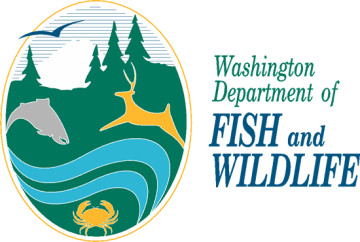 Fish and Wildlife Commission will meet by teleconference at 8:30 a.m. Friday to discuss the Columbia River salmon reforms. The public may listen to the discussion at the Department of Fish and Wildlife office, 2108 Grand Blvd. Earlier this year, the Washington and Oregon commissions adopted slightly different policies regarding the overhaul of sport and commercial fishing regulations for the lower Columbia. The biggest difference is the allocation of fall chinook salmon in 2017 and 2018, plus Washington’s intention to eliminate the use of gillnets beginning in 2019. Commission members on Friday will discuss and clarify the guidance they are giving Jim Unsworth, department director, in his negotiations with Oregon. Link 11:50
Fish and Wildlife Commission will meet by teleconference at 8:30 a.m. Friday to discuss the Columbia River salmon reforms. The public may listen to the discussion at the Department of Fish and Wildlife office, 2108 Grand Blvd. Earlier this year, the Washington and Oregon commissions adopted slightly different policies regarding the overhaul of sport and commercial fishing regulations for the lower Columbia. The biggest difference is the allocation of fall chinook salmon in 2017 and 2018, plus Washington’s intention to eliminate the use of gillnets beginning in 2019. Commission members on Friday will discuss and clarify the guidance they are giving Jim Unsworth, department director, in his negotiations with Oregon. Link 11:50
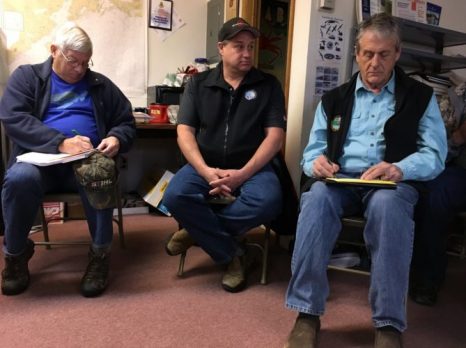
Petersburg fishermen share concerns with ADFG leadership
Two of Alaska’s top Fish and Game leaders visited Petersburg April 28 to hear from local fishermen. They discussed a variety of topics including state budget cuts to herring management and the federal observer program. About two dozen fishermen are packed into the office of the Petersburg Vessel Owner’s Association. Among the makeshift circle is Sam Cotten, the Commissioner of Fish and Game and Scott Kelley, the Director of the Division of Commercial Fisheries. Besides herring, the local fishermen also want to discuss the observer program for long liners of halibut and sable fish. It’s not a hugely popular program with fishermen because it requires them to take along a designated person to watch the fishing and document the catches. And fishermen help pay for the program through fees. They’re wondering why isn’t the program getting cut? And why are they having to fill out surveys on their catches and get observed? click here to read, listen to an audio report 10:55
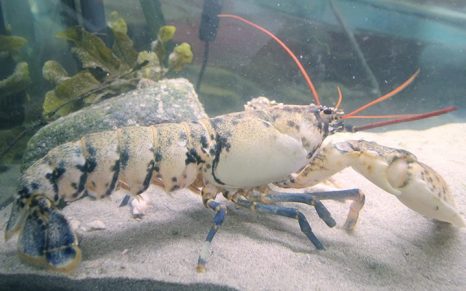
The Luck of the Irish! – Fisherman catches rare one-in-100 million albino lobster off the west of Ireland coast
A ONE-in-100 million white albino lobster has been donated to an Irish aquarium after it was saved from the chef’s cooking pot by a fisherman in Ireland. Local fisherman Charlie O’Malley caught the rare crustacean in his nets off the coast of Achill Island in Co. Mayo. The chance of catching a ‘ghost’ lobster like the one found in Achill is approximately one-in-100million. For comparison, the odds of winning the Lotto jackpot in Britain is around one-in-14million. (its certainly the prettiest lobster I’ve seen!) Click here to read the story. 09:32
Canada: Atlantic bluefin tuna not listed as an endangered species
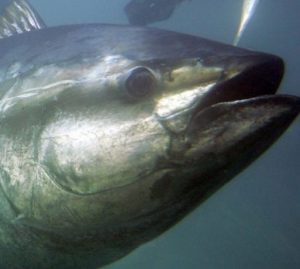 Atlantic bluefin tuna will not be listed on the endangered species list, a decision released Wednesday. The federal government’s final decision was published in the Canada Gazette saying it would not be listed under the Species at Risk Act (SARA). Fisheries and Oceans Canada rejected advice to list the species as endangered last summer, saying western Atlantic bluefin tuna stocks have been rebuilding since 2011, when the Committee on the Status of Endangered Wildlife in Canada (COSEWIC) said tuna should be listed as an endangered species under federal species-at-risk legislation. Included in the decision was the government’s rationale and the steps that will be taken to help in its recovery. If the species would have been listed on SARS, it would no longer have been allowed to be fished commercially. The in Halfax is calling on the government to take steps to work and conserve the species. (of course!) click here to read the story 08:21
Atlantic bluefin tuna will not be listed on the endangered species list, a decision released Wednesday. The federal government’s final decision was published in the Canada Gazette saying it would not be listed under the Species at Risk Act (SARA). Fisheries and Oceans Canada rejected advice to list the species as endangered last summer, saying western Atlantic bluefin tuna stocks have been rebuilding since 2011, when the Committee on the Status of Endangered Wildlife in Canada (COSEWIC) said tuna should be listed as an endangered species under federal species-at-risk legislation. Included in the decision was the government’s rationale and the steps that will be taken to help in its recovery. If the species would have been listed on SARS, it would no longer have been allowed to be fished commercially. The in Halfax is calling on the government to take steps to work and conserve the species. (of course!) click here to read the story 08:21
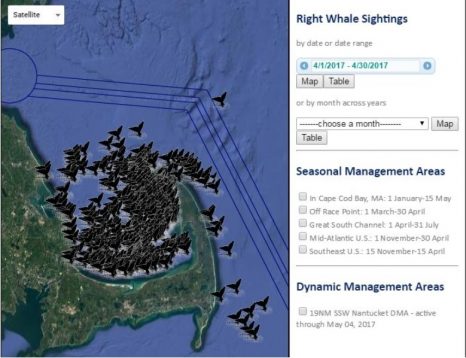
No lobstering until right whales leave Cape Cod Bay
For the past three years there has been a ban on setting lobster traps and pots in the bay from Feb. 1 through the end of April, a ban intended to protect these whales from entanglement. Last week by some counts close to 200 of the estimated total population of 500 Atlantic Western Right Whales were still in Cape Cod Bay. Citing their endangered status and their surprising willingness to stay in the bay because of an abundance of the plankton they feed on, the state’s Division of Marine Fisheries announced that most of the bay would remain closed to setting recreational and commercial lobster traps and pots through next Sunday, May 7. For environmentalists involved in the protection of this species of whale the extended ban was a reasonable, measured action. For many lobstermen it was salt on an open wound. click here to read the story 07:56
Maine lawmakers endorse tougher penalties for lobstermen who cheat
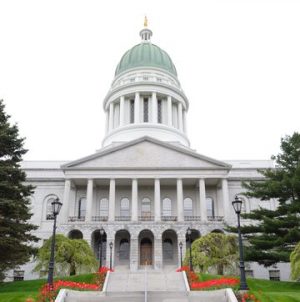 A legislative committee voted unanimously Wednesday to toughen penalties on lobstermen who fish too many traps or use “sunken trawls” as part of an industry-supported effort to crack down on lawbreakers. “I do think this is going to get people’s attention and will hopefully make people realize that it doesn’t pay to cheat,” said Patrice McCarron, executive director of the Maine Lobstermen’s Association. Lawmakers are considering a suite of requests from the Maine Department of Marine Resources for more enforcement tools and tougher sanctions against violators in an industry worth more than $500 million last year. A bill unanimously endorsed by the Marine Resources Committee, L.D. 575, would allow DMR’s commissioner to order longer license suspensions for lobstermen who violate the laws on the first offense and, in several cases, permanently revoke the licenses of repeat offenders. click here to read the story 19:49
A legislative committee voted unanimously Wednesday to toughen penalties on lobstermen who fish too many traps or use “sunken trawls” as part of an industry-supported effort to crack down on lawbreakers. “I do think this is going to get people’s attention and will hopefully make people realize that it doesn’t pay to cheat,” said Patrice McCarron, executive director of the Maine Lobstermen’s Association. Lawmakers are considering a suite of requests from the Maine Department of Marine Resources for more enforcement tools and tougher sanctions against violators in an industry worth more than $500 million last year. A bill unanimously endorsed by the Marine Resources Committee, L.D. 575, would allow DMR’s commissioner to order longer license suspensions for lobstermen who violate the laws on the first offense and, in several cases, permanently revoke the licenses of repeat offenders. click here to read the story 19:49
‘Deadliest Catch’ star Nick McGlashan says he was ‘a full blown junkie’ addicted to heroin, meth
 Captain Wild Bill Wichrowski’s longtime deck boss, Nick McGlashan, revealed he was a former drug addict during Tuesday’s episode of Discovery’s “Deadliest Catch.” And now, McGlashan detailed his addiction to fans via an article he linked to on Twitter. He revealed his substance abuse was even worse than what “Deadliest Catch” showed. click here to read the story 16:10
Captain Wild Bill Wichrowski’s longtime deck boss, Nick McGlashan, revealed he was a former drug addict during Tuesday’s episode of Discovery’s “Deadliest Catch.” And now, McGlashan detailed his addiction to fans via an article he linked to on Twitter. He revealed his substance abuse was even worse than what “Deadliest Catch” showed. click here to read the story 16:10
The Deadliest Disease – A lifestyle of the Bering Sea Crabber is a dream for many, but a reality for few. Hard work and fast money make this a lucrative industry enviable for the hopeful masses. The ruthless, persistent, yet beautiful Mother Nature is our greatest adversary. She hits us with winds exceeding 60 miles per hour, bites us with temperatures that dip below -30 degrees, and relentlessly threatens us with waves taller than a three story building. With an injury rate over 90%, it’s one of the most dangerous working environments on the planet. It’s no wonder why there is only 350 people in the world who can claim this as a career. My life went from Bering Sea badass to full blown junkie very rapidly. Hidden from me was that passion I had for life. Taken from me was my ability to live. I was at war with my addiction and it was winning. click here to read the article by Nick McGlashan 16:17
Bill to move Monhegan wind power project draws crowd to legislative hearing
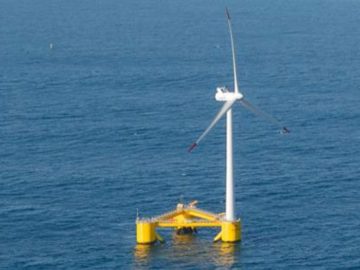 Lawmakers heard passionate, conflicting testimony Tuesday from dozens of people on a bill aimed at moving a nationally significant wind energy test site farther from Monhegan Island. Supporters said views of two massive floating turbines would jeopardize tourism, lobster fishing, migrating birds and the sense of serenity associated with Monhegan’s wild beauty. Some said island residents were being bullied and divided by the University of Maine and the partners of Maine Aqua Ventus, a project that is testing new technology for offshore wind turbines about 3 miles from the island. The project initially promised a small, brief test, but has now expanded it beyond anyone’s expectations. Opponents of the bill, which would move the test site at least 7 miles farther out to sea, said it is unneeded and unwelcome, adding that it would short-circuit the process by which islanders are evaluating the project’s potential benefits. Both sides said much is at stake. But representatives of the Maine Lobstering Union, which represents 500 fishermen, said wind power has no place on the Maine coast. Other lobstermen, though, spoke in favor of the turbines. Mary Weber, whose husband, Matt, fishes around the island, said they didn’t think the turbines would deter tourists, and might even draw a new set of visitors interested in clean energy. click here to read the story 15:30
Lawmakers heard passionate, conflicting testimony Tuesday from dozens of people on a bill aimed at moving a nationally significant wind energy test site farther from Monhegan Island. Supporters said views of two massive floating turbines would jeopardize tourism, lobster fishing, migrating birds and the sense of serenity associated with Monhegan’s wild beauty. Some said island residents were being bullied and divided by the University of Maine and the partners of Maine Aqua Ventus, a project that is testing new technology for offshore wind turbines about 3 miles from the island. The project initially promised a small, brief test, but has now expanded it beyond anyone’s expectations. Opponents of the bill, which would move the test site at least 7 miles farther out to sea, said it is unneeded and unwelcome, adding that it would short-circuit the process by which islanders are evaluating the project’s potential benefits. Both sides said much is at stake. But representatives of the Maine Lobstering Union, which represents 500 fishermen, said wind power has no place on the Maine coast. Other lobstermen, though, spoke in favor of the turbines. Mary Weber, whose husband, Matt, fishes around the island, said they didn’t think the turbines would deter tourists, and might even draw a new set of visitors interested in clean energy. click here to read the story 15:30
While the Trudeau Administration pays lip service, FISH-NL warns of rising unrest if Ottawa doesn’t soon act on fisheries crisis
 The Federation of Independent Sea Harvesters of Newfoundland and Labrador (FISH-NL) warns of rising unrest in the fishing industry if Ottawa doesn’t follow through on commitments to inshore fish harvesters. “So far the Trudeau administration has paid lip service to unrest in the Newfoundland and Labrador fishery,” said Ryan Cleary, President of FISH-NL. “That won’t cut it anymore because harvesters are at the end of their rope.” The state of the fisheries today is described as worse than the early 1990s when groundfish stocks such as cod collapsed. Back then, harvesters moved on to other species such as shrimp and crab, but now most fisheries are at a critical level or on a downward spiral. Debt levels are also higher, and — given severe cuts to quotas for species like shrimp — many harvesters are teetering on bankruptcy. click here to read the press release 13:06
The Federation of Independent Sea Harvesters of Newfoundland and Labrador (FISH-NL) warns of rising unrest in the fishing industry if Ottawa doesn’t follow through on commitments to inshore fish harvesters. “So far the Trudeau administration has paid lip service to unrest in the Newfoundland and Labrador fishery,” said Ryan Cleary, President of FISH-NL. “That won’t cut it anymore because harvesters are at the end of their rope.” The state of the fisheries today is described as worse than the early 1990s when groundfish stocks such as cod collapsed. Back then, harvesters moved on to other species such as shrimp and crab, but now most fisheries are at a critical level or on a downward spiral. Debt levels are also higher, and — given severe cuts to quotas for species like shrimp — many harvesters are teetering on bankruptcy. click here to read the press release 13:06
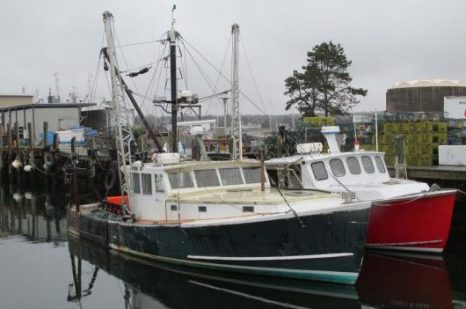
Athearn Marine Agency Boat of the Week: 44′ Stanley Fiberglass Scalloper, Detroit 8-V-92
Specifications, information and 30 photo’s click here To see all the boats in this series, Click here 12:24
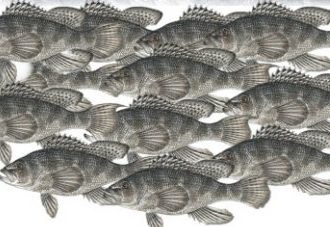
What’s so hard about managing fisheries?
Nils Stolpe/FishNet USA May 3, 2017 – “We live in a world in which data convey authority. But authority has a way of descending to certitude, and certitude begets hubris. From Robert McNamara to Lehman Brothers to Stronger Together, cautionary tales abound. We ought to know this by now, but we don’t. Instead, we respond to the inherent uncertainties of data by adding more data without revisiting our assumptions, creating an impression of certainty that can be lulling, misleading and often dangerous. Ask Clinton” Stephens, B., Climate of Complete Certainty, NY Times, 4/28/17. The above quote was from an op-ed piece by Bret Stephens, the New York Times’ recently acquired columnist. While he was targeting climate scientists, their “disciples” and the overblown pseudo-science hidden beneath an oversufficiency of less than convincing statistics that is used to strengthen their arguments, it appears that fisheries scientists are increasingly adopting the same techniques (the emphasis is mine) to support their often erroneous – sometimes sadly so – conclusions. Click here to read the article. 10:48
Letter: ‘Codfather’ permits should be redistributed
 To the editor: Carlos Rafael’s environmental crime spree, spanning two decades, will finally come to an end (”’Codfather’ faces $109K fine, loss of 13 vessels,” April 3). Rafael pled guilty to federal charges of falsifying fish catch reports, conspiracy and tax evasion. He will serve at least four years in jail and will forfeit millions of dollars in fishing assets. For law-abiding fishermen, this day is long overdue. While other fishermen were complying with steep reductions in fishing quotas, Rafael decided those rules didn’t apply to him. click here to read the letter 09:22
To the editor: Carlos Rafael’s environmental crime spree, spanning two decades, will finally come to an end (”’Codfather’ faces $109K fine, loss of 13 vessels,” April 3). Rafael pled guilty to federal charges of falsifying fish catch reports, conspiracy and tax evasion. He will serve at least four years in jail and will forfeit millions of dollars in fishing assets. For law-abiding fishermen, this day is long overdue. While other fishermen were complying with steep reductions in fishing quotas, Rafael decided those rules didn’t apply to him. click here to read the letter 09:22
Louisiana Inshore Shrimp Season Discussion, Commision Meeting on Thursday to be live streamed
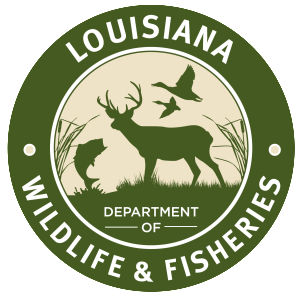 The opening dates for this year’s spring inshore shrimp season in Louisiana will be discussed at a meeting this Thursday. The Louisiana Department of Wildlife and Fisheries will hold a commission meeting at 1:30 p.m. Thursday at the department’s headquarters building, 2000 Quail Drive, Baton Rouge. Ideal conditions for shrimp to grow are when temperatures rise above 68 degree and salt levels in the water are high. So far, conditions are favorable to open the season with good-sized shrimp, said Jeff Marx, biologist for the department, at a previous department meeting in April. Earlier this month, there was even talk of having a special meeting before May 4 to set the inshore shrimp season. The meeting will be streamed online (click here) for those who cannot attend in person. The full agenda and more information can be found online at wlf.louisiana.gov click here to read the story 08:09
The opening dates for this year’s spring inshore shrimp season in Louisiana will be discussed at a meeting this Thursday. The Louisiana Department of Wildlife and Fisheries will hold a commission meeting at 1:30 p.m. Thursday at the department’s headquarters building, 2000 Quail Drive, Baton Rouge. Ideal conditions for shrimp to grow are when temperatures rise above 68 degree and salt levels in the water are high. So far, conditions are favorable to open the season with good-sized shrimp, said Jeff Marx, biologist for the department, at a previous department meeting in April. Earlier this month, there was even talk of having a special meeting before May 4 to set the inshore shrimp season. The meeting will be streamed online (click here) for those who cannot attend in person. The full agenda and more information can be found online at wlf.louisiana.gov click here to read the story 08:09
What’s next for Carlos Rafael’s fishing permits?
 New Bedford – Almost a week ago, City Council members asked for their names to be attached to a late file agenda pertaining to Carlos Rafael’s groundfish permits. Behind Ward 4 Councilor Dana Rebeiro, Council President Joseph Lopes and Ward 5 Councilor Kerry Winterson, the council requested “that the Committee on Internal Affairs meet with Attorney General Maura Healey and NOAA to discuss how current owners and mariners operating in New Bedford have the first right of refusal to acquire licenses to be auctioned as result of the plea agreement in the case of The United States vs. Carlos Rafael… The written motion was a bit premature. Following Thursday’s council meeting, Rebeiro acknowledged the measure was “to get ahead of the ball” in terms of where the permits may land. So what’s next? click here to read the story 19:11
New Bedford – Almost a week ago, City Council members asked for their names to be attached to a late file agenda pertaining to Carlos Rafael’s groundfish permits. Behind Ward 4 Councilor Dana Rebeiro, Council President Joseph Lopes and Ward 5 Councilor Kerry Winterson, the council requested “that the Committee on Internal Affairs meet with Attorney General Maura Healey and NOAA to discuss how current owners and mariners operating in New Bedford have the first right of refusal to acquire licenses to be auctioned as result of the plea agreement in the case of The United States vs. Carlos Rafael… The written motion was a bit premature. Following Thursday’s council meeting, Rebeiro acknowledged the measure was “to get ahead of the ball” in terms of where the permits may land. So what’s next? click here to read the story 19:11
Long List of Factors Stressing Out (poisoning) Narragansett Bay
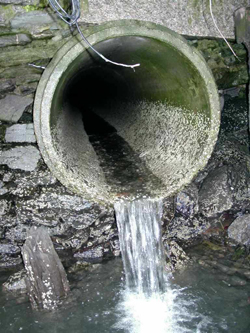 The Narragansett Bay Estuary Program has developed a draft report on the status of Narragansett Bay entitled “State of the Bay and its Watershed.” Numerous factors, beyond climate change, sea-level rise and legacy contaminants, stress Rhode Island’s most significant natural resource. Here is a look at some of the others detailed in the NBEP’s draft report.,, Population growth, Land-use changes, Impervious surfaces, Nutrient loading, Chemical contaminants of emerging concern (CECs). They include but aren’t limited to nonprescription and prescription pharmaceuticals, personal-care products, and industrial chemicals used in a wide range of consumer, commercial and industrial products. Some examples: antidepressants, antihypertensives, antibiotics, painkillers and synthetic hormones; antimicrobials such as Triclosan; UV blockers in sunscreens such as oxybenzone; DEET, a pesticide which is applied to human skin; fragrances such as synthetic musks; flame retardants such as polybrominated diphenyl ethers; additives to plastics; and synthetic materials such as bisphenol A, commonly referred to as BPA. click here to read the story 16:53
The Narragansett Bay Estuary Program has developed a draft report on the status of Narragansett Bay entitled “State of the Bay and its Watershed.” Numerous factors, beyond climate change, sea-level rise and legacy contaminants, stress Rhode Island’s most significant natural resource. Here is a look at some of the others detailed in the NBEP’s draft report.,, Population growth, Land-use changes, Impervious surfaces, Nutrient loading, Chemical contaminants of emerging concern (CECs). They include but aren’t limited to nonprescription and prescription pharmaceuticals, personal-care products, and industrial chemicals used in a wide range of consumer, commercial and industrial products. Some examples: antidepressants, antihypertensives, antibiotics, painkillers and synthetic hormones; antimicrobials such as Triclosan; UV blockers in sunscreens such as oxybenzone; DEET, a pesticide which is applied to human skin; fragrances such as synthetic musks; flame retardants such as polybrominated diphenyl ethers; additives to plastics; and synthetic materials such as bisphenol A, commonly referred to as BPA. click here to read the story 16:53
Massachusetts Court Reverses Ruling in Rotten Scallop Coverage Dispute
 The Massachusetts Appeals Court has reversed a lower court’s ruling in a case examining whether damage to scallops at a seafood processing facility, when the cause of damage is unknown, constitutes an occurrence within a commercial general liability (CGL) policy. A Superior Court judge previously concluded that defendant and insured, Raw 2 Seafoods Inc. (RSI), had no way of proving its claimed loss was caused by an occurrence and granted summary judgement in favor of the plaintiff and insurer, Hanover Insurance Group. This case, The Hanover Insurance Group, Inc. vs. Raw Seafoods, Inc., comes after a July 2011 event in which RSI-processed scallops were making their way through customs in Denmark, heading to an Atlantic customer. Upon inspection, the 37,102 pounds of scallops were found to be decomposed and were deemed unacceptable for human consumption. click here to read the story 15:51
The Massachusetts Appeals Court has reversed a lower court’s ruling in a case examining whether damage to scallops at a seafood processing facility, when the cause of damage is unknown, constitutes an occurrence within a commercial general liability (CGL) policy. A Superior Court judge previously concluded that defendant and insured, Raw 2 Seafoods Inc. (RSI), had no way of proving its claimed loss was caused by an occurrence and granted summary judgement in favor of the plaintiff and insurer, Hanover Insurance Group. This case, The Hanover Insurance Group, Inc. vs. Raw Seafoods, Inc., comes after a July 2011 event in which RSI-processed scallops were making their way through customs in Denmark, heading to an Atlantic customer. Upon inspection, the 37,102 pounds of scallops were found to be decomposed and were deemed unacceptable for human consumption. click here to read the story 15:51

Benjamin Franklin Was the First to Chart the Gulf Stream
Texas House passes H.B.1260, The “Gulf Shrimp Liberty Act”
 The Texas House passed House Bill 1260 by State Representative Dade Phelan, which creates a new occupational license for non-Texas commercial shrimpers for the unloading of shrimp. Currently, Texas has a moratorium on commercial Gulf shrimper licenses, meaning no new licenses are being issues and haven’t been issued in several years. The shrimpers being referred to in HB 1260 are the more than 500 out-of-state Gulf shrimpers who are currently not allowed to come into Texas waters without a license. “HB 1260 opens up the Texas seafood market to 7 million pounds of Gulf shrimp and over $100 million in economic activity for the state of Texas”, Representative Phelan stated. “The ability for non-Texas shrimpers to unload in Texas also means that they will refuel, gather supplies, and perform maintenance on their boats, providing more jobs and generating sales tax revenue that will positively impact the coast.” click here to read the story 11:56
The Texas House passed House Bill 1260 by State Representative Dade Phelan, which creates a new occupational license for non-Texas commercial shrimpers for the unloading of shrimp. Currently, Texas has a moratorium on commercial Gulf shrimper licenses, meaning no new licenses are being issues and haven’t been issued in several years. The shrimpers being referred to in HB 1260 are the more than 500 out-of-state Gulf shrimpers who are currently not allowed to come into Texas waters without a license. “HB 1260 opens up the Texas seafood market to 7 million pounds of Gulf shrimp and over $100 million in economic activity for the state of Texas”, Representative Phelan stated. “The ability for non-Texas shrimpers to unload in Texas also means that they will refuel, gather supplies, and perform maintenance on their boats, providing more jobs and generating sales tax revenue that will positively impact the coast.” click here to read the story 11:56

Offshore Wind Farm Costs $150,000 Per Home Currently Powered
An offshore wind farm in Rhode Island went online Monday, but building it costed $150,000 for every household powered. Three miles off the coast of Block Island, R.I., the wind farm is currently generating enough electricity to power 2,000 homes, but building the five turbines costed $300 million. That’s roughly $150,000 per household just to build the turbines, not to operate them. To put this in some perspective, the U.S.’s newest nuclear reactor, Watts Bar Unit 2, cost $4.7 billion to build but powered 4.5 million homes. The extremely high cost of offshore wind doesn’t worry environmentalists and progressives however, because, “it’s the precedent that counts.” click here to read the rest 11:37
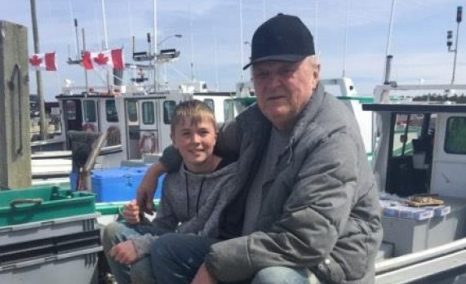
Family that fishes together: Bill MacEachern passing on tradition to next generation
Lobster season is under way in northeastern New Brunswick. Fishermen set out from wharves all along the north shore and Acadian Peninsula at first light Monday morning to set their traps. It’s a time-honoured tradition, especially for Bill MacEachern, who has been fishing out of Tabusintac for 55 years. Everything went well on day one, he told Shift‘s Vanessa Vander Valk. “It went great. It was a beautiful day, everybody got set, there were only two or three boats that had little problems,” he said. “Usually a few fellows have their motors go or something like that happen, but this year everybody was really lucky.” After 55 years on the water, he’s seen it all in the industry. “You wouldn’t believe the changes,” he said. click here to read the story, and watch a video 09:21
No fishery disaster relief funds for nine West Coast fisheries in Congress’ $1T spending bill
 Lawmakers on Monday unveiled a huge $1 trillion-plus spending bill that would fund most government operations through September but would deny President Donald Trump money for a border wall and rejects his proposed cuts to popular domestic programs. The bill also does not include millions in disaster relief funds for nine West Coast fisheries that fishermen and a group of 17 West Coast senators and members of Congress had hoped congressional leaders would include. “We’re definitely not holding out hope for any sort of last minute tack-on for the deal, but there is always the opportunity for Congress to appropriate separately,” Pacific Coast Federation of Fishermen’s Associations Executive Director Noah Oppenheim told the Times-Standard on Monday. “Although, the chances of that happening are slim to none.” click here to read the story 08:21
Lawmakers on Monday unveiled a huge $1 trillion-plus spending bill that would fund most government operations through September but would deny President Donald Trump money for a border wall and rejects his proposed cuts to popular domestic programs. The bill also does not include millions in disaster relief funds for nine West Coast fisheries that fishermen and a group of 17 West Coast senators and members of Congress had hoped congressional leaders would include. “We’re definitely not holding out hope for any sort of last minute tack-on for the deal, but there is always the opportunity for Congress to appropriate separately,” Pacific Coast Federation of Fishermen’s Associations Executive Director Noah Oppenheim told the Times-Standard on Monday. “Although, the chances of that happening are slim to none.” click here to read the story 08:21
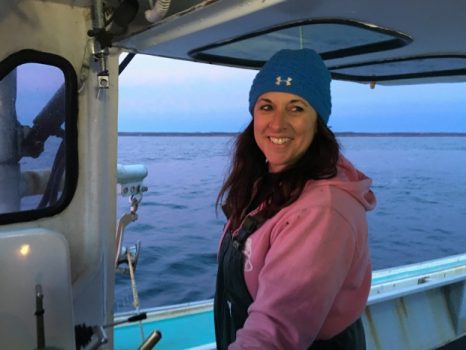
Pulling the traps: Captain Shelley Deagle says the season looks positive
Lobster fishermen on Prince Edward Island’s north shore are hopeful today’s catch will give them an indication of what the two-month spring season may bring. Captain Shelley Deagle is one of the fishermen who headed out before sunrise from Naufrage, P.E.I., on the Miss Shawna Lee to start pulling traps with her cork, Dougie MacKinnon. The captain said there were lobsters in the traps, adding that’s a good sign of the season to come. “They’re talking a good price again this year,” said Deagle referring to a meeting held Friday with the fish buyer. click here to view the images, and read the story 19:49
Fisherman backs shark-cull tourism
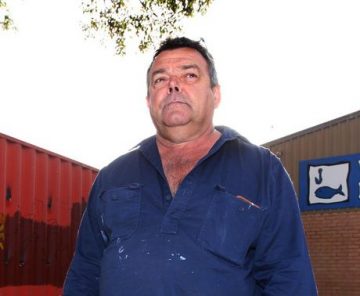 A third-generation Albany commercial fisherman has weighed into the ongoing shark cull debate, suggesting that the State Government explore the prospect of giving charter operators the licence to catch great white sharks as a tourism venture. Tony Westerberg, who has fished off the waters of the south coast for more than 40 years, says the ramifications of the reduction of shark fishing licences were evident, with surfers and divers continually being attacked. Teenager Laeticia Brouwer was the 15th person to be killed by a shark in WA since 2000 when she was attacked while surfing with her father in Esperance last month, prompting the debate’s reignition. click here to read the story 18:34
A third-generation Albany commercial fisherman has weighed into the ongoing shark cull debate, suggesting that the State Government explore the prospect of giving charter operators the licence to catch great white sharks as a tourism venture. Tony Westerberg, who has fished off the waters of the south coast for more than 40 years, says the ramifications of the reduction of shark fishing licences were evident, with surfers and divers continually being attacked. Teenager Laeticia Brouwer was the 15th person to be killed by a shark in WA since 2000 when she was attacked while surfing with her father in Esperance last month, prompting the debate’s reignition. click here to read the story 18:34






